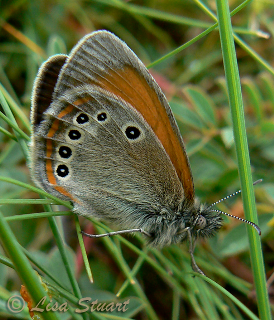It's highly likely that I'd already seen some of these butterflies without positively identifying them..... These first three were, however, unmistakable.
I'd been hankering after seeing a Camberwell beauty, Nymphalis antiopa, for years. This year was my lucky one. The first warmth of the sun in early April had brought two males out of hibernation, battling for territory. Sadly the only spot they fancied landing in was a fenced-in vegetable plot.

Walking along a track above the Hermida gorge to my mate Michael's "rock garden" a month later, it was still a little early for the Man orchids to be festooning the cliff side, just one or two of the first green spikes showing and an as yet unidentified green-flowering plant. There aren't many green butterflies, not in the western palearctic anyway, so my first sighting of a Green hairstreak, Callophrys rubi, flitting about the latter was at once exciting and perplexing that I'd never noticed one before. As the butterfly settled to sunbathe the iridescent emerald on its underwing glinted in the sun as it tilted.
Another couple of months passed before my most thrilling "lifer", my first Apollo! Parnassius apollo is a frequenter of higher mountain greenery so I forgive myself for having previously missed out on the species. This particular, rather bedraggled specimen swept enticingly past me as I pottered along a stream, at around 1,500m in the Cantabrian mountains in the province of León and part of the Picos de Europa Regional Park. It eventually deigned to settle on the ground briefly for me to have a closer look.
Along the same streamside Greater burnet, Sanguisorba officinalis, was in flower - the favourite plant of an even rarer butterfly, the Dusky (certainly) large (not so you'd notice) blue, Phengaris nausithous.
After capturing the bronze glinting underwing I managed a very blurry shot of its glistening blue upperside.
Slightly further afield near the Palencian town of Aguilar de Campoo, I'd joined one of Teresa's tours for a day out in mid-June. While enjoying a good rummage among the orchids on a srubby hillside another butterfly caught my eye. Gatekeeperish, I thought, but with a much richer colouring. I was chuffed to have found a Spanish chestnut heath, Coenonympha glycerion iphioides. And what spectacular eyes you have!
Other days out with T, and children taught me to look out for the zigzag bar across the first cell of the forewing of Esper's marbled whites, Melanargia russiae.
This pair were otherwise occupied and obliged nicely.
High summer and August brought Great banded graylings, Brintesia circe, also in Palencia.
Along with a gorgeous female Long-tailed blue, Lampides boeticus.
So gorgeous in fact that she was attracting males of other species.
I think the final photo is one of these confused Mazarine blue males, Polyommatus semiargus.




















